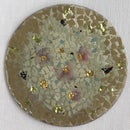Introduction: Naturally Gilded Easter Eggs
We’re crafting at home, rummaging through art boxes, pantry cupboards and bookshelves for inspiration. You might find you have a wealth of materials just begging to be put to creative use. Trying something new can fill your spirit with joy! Today we’re using some kitchen ingredients and tools to gild Easter eggs. We were lucky to find brown and white eggs at the grocery store, and some naturally blue and green araucana hen eggs at the local farmers market. The leaf clings to the surface of the egg, creating a glow you’ll never see with paint. These eggs can be eaten, so nothing goes to waste. Let’s get started on these free-form gilded beauties.
Supplies
Rimmed washable tray or baking sheet
A dozen eggs (or more as you can spare), brought to a gentle boil, covered and left off heat for 10 minutes, then chilled in cool water to room temperature, and dried.
Two square or round small brushes for painting the glue solution or “size” onto eggs (a brush per person)
Two soft brushes for picking up pieces of leaf Vegetable oil or lip balm
Packet (1/4 oz) of powdered, unflavored food gelatin – this will make your gilding glue
Clear measuring cup, teaspoon and metal stirring spoon
Sepp Gilding Workshop Imitation Gold Leafbook of 25 leaves – or a book of Genuine Gold loose “Surface” Leaf – don’t use patent/transfer leaf for this project*
A couple of cotton balls or pads
*You can find the gold leaf where Sepp Gilding Workshop products are sold. You may have to wait a couple of days for your order to ship, but art stores are working hard to fulfill shipments at this time.
Step 1: Make Your Gelatine-Based Gold Size
Use ½ of one packet (or about 1½ teaspoons) of gelatine, and sprinkle it over ¼ cup room temperature water in a liquid measuring cup. Swirl it around a bit. Bring some water to a boil and after removing from heat for a minute, pour the hot water into the measuring cup to make 1½ cups of gelatin solution. You don’t want the water to be boiling when you pour it as this level of heat will break the protein down and it won’t make a sticky adhesive. Stir with a spoon to completely dissolve.
Step 2: Preparing the Craft Area
Place your measuring cup of size and your bowl of boiled eggs inside the rimmed tray or baking sheet – this will catch the drips. Open up your book of Imitation Gold or Genuine Gold Leaf, and remove a couple of squares of leaf. You can gently tear Imitation Gold Leaf into smaller pieces. If you’re using real gold, tap the gold with your dry, clean “pick up” brush to break it into small pieces. Move slowly so as not to disturb the leaf which may want to fly!
Apply a tiny amount of vegetable oil or lip balm on the back of your hand. Swipe the tip of your dry pick up brush (NOT the size brush) over the oil. This provides cling to pick up your leaf.
Step 3: Applying the Gelatine Size and the Gold Leaf
This is a quick process – unlike some other types of gilding where you must wait till the glue has dried for a while, you’ll add the gold immediately after applying the size. Hold your egg over the tray. Dip your brush in the gelatin solution, and dab some free-style brush strokes over the surface of the egg. It will drip and that’s ok, you want the areas to be gilded to be nice and wet.
Using your pick up brush, gently scoop up a piece of leaf and drop it onto the wet areas. Try not to get your pick up brush wet. Don’t worry about missing a spot - it’s impossible to make a less than lovely gilded finish with this technique! You can use your brush to nudge down any leaf bits that are sticking up, or blow gently to push the leaf down. Prepare more leaf as necessary to continue gilding your eggs.
Step 4: Allow the Gilded Eggs to Dry
Set your gilded eggs onto an egg carton to dry in a warm, draft-free place.
Step 5: Polish Your Gold Eggs
After 2-3 hours, your eggs will be dry. Gently polish them with a cotton ball or pad. If you feel moisture, wait a little longer. Use the cotton to brush away wrinkles and buff the leaf down.
Step 6: Decorate
Refrigerate your eggs till ready to display – these make a stunning centerpiece, gift, or golden surprise for an egg hunt! Note: wash your hands after peeling eggs for eating.





